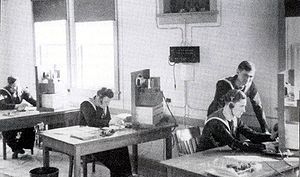Naval Radio Station CFF - Experimental Farm
| Naval Radio Station CFF - Experimental Farm | |
|---|---|
| Ottawa | |
 | |
| Coordinates | |
| In use | 1941 - 1947 |
First, rough sketches of a receiving station were drawn up for approval then given to Public Works in order that they would draw up specifications. It also had to be decided where to situate the new station,. After scouting likely sites, it was decided that the Experimental Farm in Ottawa offered the best location. It was ideal because there were no other buildings in the vicinity and it was free of electrical noise. Once permission was obtained to install the facility, construction was completed in short order. Although the building was modest, the surrounding fence was anything but. Laid out to enclose a square that measured approximately 230 feet a side, the eight foot fence was tipped with several strands of barbed wire. For added security, the metal fence posts were set into a concrete foundation but the area's gradual slope toward the northeast meant that a large section of it tended to resemble a windowless wall. This helped give rise to speculation among some Farm personnel that much of the installation was actually a system of underground bunkers.
The building's placement at a distance from the highway and the tendency of the naval personnel to keep to themselves helped the station to maintain a low profile. George Guest, a leading telegraphist at the station until December 1941, recalls that "when things were quiet, we skied on the hill." They also skied to work in winter or paddled to work in summer, via the Rideau Canal.
Once CFF became operational, it linked naval headquarters in Ottawa with Allied naval headquarters, ships at sea and other locations as distant as Bermuda and Sierra Leone. Station personnel also intercepted encrypted German, Italian and Russian military and diplomatic communications traffic. When not occupied with other messages, the operators on duty "sniped" - slang for intercepted - other Allied traffic. On one occasion, they followed, intercepted transmissions between Royal Navy warships in persuit and the ultimate sinking of the German battleship Bismarck.
Related Pages
Related Items
References
- ↑ Page content is originally from Radio Communications and Signals Intelligence in the Royal Canadian Navy and used with permission.
